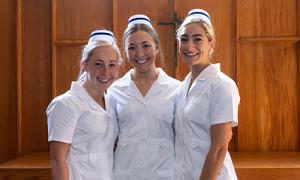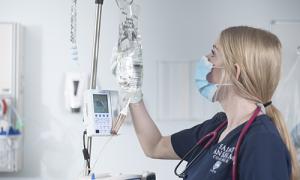The nationally acclaimed nursing program at Saint Anselm College is poised to make big strides in an increasingly competitive field with the establishment of a School of Nursing and Health Sciences and the construction of a state-of-the-art learning facility.

Saint Anselm College President Joseph A. Favazza, Ph.D., formally announced the plans in June, which include the expansion of healthcare partnerships and the beginning of graduate programs, following the recommendations of the Presidential Nursing Commission and consultation with the nursing department and faculty leadership.
A School of Nursing and Health Sciences would position the department for growth in graduate programs, community collaborations, and more.
“Without a doubt, our nursing program is among the finest in the country and features some of the best outcomes at the college,” President Favazza said. “The steps we are taking will ensure that we maintain our elite position while remaining distinctly Anselmian.”
The Saint Anselm nursing program was established in the 1950s, and it didn’t take long to be recognized as one of the best in the region. Today, the nursing students who enter Gadbois Hall in their freshman year emerge four years later prepared to excel in their chosen discipline.
Considered one of the most respected programs in New England, Saint Anselm nursing students learn through hands-on experience in the college’s simulation labs and hospital clinical rotations that begin in the sophomore year.
While the technical nursing skills are sharpened through these experiences, a humanistic approach to patient care, strong critical-thinking skills, and ethical decision-making are honed by the nursing department and enhanced by a strong foundation in the liberal arts. This combination produces students who are highly attractive candidates to nursing hiring managers in New Hampshire, Boston, and beyond.
“I find myself working with patients and their families in a very holistic manner that I often don’t recognize in other co-workers,” says Mallory Schell ’19, a critical care nurse at Dartmouth Hitchcock Medical Center in Hanover. “I think back on my ethics courses a lot more than I ever thought I would, and utilize my philosophy, theology, and humanities knowledge to bridge the gap between science and human experience.”
Students consistently outpace the national average on the NCLEX nursing licensure exam; the class of 2021 first-time pass rate of 98.84 percent was significantly higher than the national average of 86.06 percent. Since 2017, 97 percent of Saint Anselm nurses have been employed within the first six months of graduation, according to the First Destination Survey.
A growing demand for nurses nationwide has sparked other colleges and universities to expand or create nursing programs, looking to take market share from places like Saint Anselm. With this trend in mind, President Favazza charged the Nursing Commission to study how Saint Anselm could maintain and grow its strong position in the field of nursing.
Following the commission’s recommendations and the endorsement of the board of trustees in the spring of 2022, President Favazza asked the new vice president of Academic Affairs, Sheila Liotta, Ph.D., to lead the transition to the School of Nursing and Health Sciences model, begin the search for a dean of the school, and help guide the plans for the new nursing facility.
While at Providence College, Liotta served as the founding dean of the School of Arts & Sciences, helping guide the transition through a transparent and inclusive process.
“The creation of a school is certainly a major step, and we are designing all of the processes to be sure a range of voices are heard,” she says. “I am confident that we can evolve into this new structure while preserving the feeling of community on campus that is the heart of what makes Saint Anselm College such a special place.”
Liotta has appointed a transition team comprised of nursing faculty and faculty from other departments, along with academic administrators, to make recommendations about the organization and governance of the school in early spring of 2023.
“We expect this will help to define the school’s position in relationship to other departments on campus, as well as the nursing department itself. It is crucial that this change is overseen by faculty,” Liotta says.
A search is underway for a dean of the school who will manage partnerships with companies and hospitals, and work with the college’s marketing, enrollment, and advancement teams to position the program to attract the next generation of nursing students. The goal is to select a dean who will begin in July 2023.
“The new school will be a way to support our excellent nursing program with new resources, such as a new building and facilities. It will also help us consider new ways to create partnerships between nursing and others on campus, as well as with healthcare venues and the wider community in the Manchester area,” Liotta says.
While the transition to the school model is taking place, plans are advancing for the new nursing facility.
The new building is expected to be 40,000- to 50,000-square-feet in size with an estimated cost between $20 and $25 million. It would include nursing simulation labs, high-fidelity patient simulators, classrooms, office space, and other special features. It will support undergraduate programs as well as future graduate and certificate programs in nursing and health professions.
“We are excited by the prospect of a state-of-the-art building, which will provide a modern learning environment and allow us to expand our lab and simulation capabilities as we move forward,” says Maureen O’Reilly, Ph.D., executive director of the nursing department. “We are very proud of our program, and our goal is to maintain the quality education which produces the outstanding nurses that employers have come to expect.”
A building committee is currently working with architectural firm Lavallee Brensinger on the siting and design of the facility. A groundbreaking is expected in the fall of 2023.
In addition to the nursing department, additional academic programs may be part of the school, including the new majors in health sciences and public health. Faculty members are also considering the addition of an interdisciplinary center focused on social determinants of health, an initiative that would include research and outreach that would connect Saint Anselm more robustly to the Greater Manchester community.
While there is still a considerable amount of work to do, the plans have already created a buzz among prospective students. Vice President of Enrollment Steven Goetsch says 15 students in the Class of 2026 enrolled in the nursing program on the day President Favazza announced plans for the new facility last spring.
The expansion of partnerships with local institutions is also a priority. The college already has strong relationships with local hospitals, with many providing clinical experiences to students, and last year a partnership was announced between Saint Anselm and Catholic Medical Center to build a 13,000-square-foot simulation lab on the hospital’s Manchester campus. The project received a $2 million federal grant to advance the project.
“Partnerships such as this will help build on the strong relationship we have with hospitals for clinical experiences and other training opportunities,” President Favazza said.
In concluding its report, the Nursing Commission emphasized “a sense of urgency” in advancing the recommendations, which are aimed at supporting a longtime signature program at Saint Anselm.
“The spirit of the proposal aligns with the mission of the college and supports fundamental elements within the strategic plan. We are confident that the stakeholders at Saint Anselm College will realize significant benefits when these recommendations are implemented,” they wrote.
We are excited by the prospect of a STATE- OF-THE-ART BUILDING, which will provide a modern learning environment and allow us to expand our lab and simulation capabilities as we move forward.


